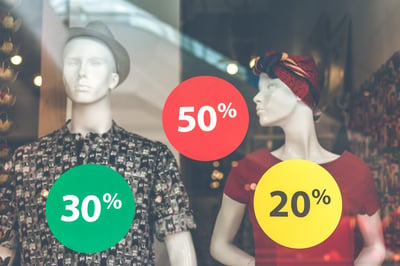Where to e-commerce? Southeast Asia edition
With a projected market volume of over 45 billion USD in 2023, Southeast Asian e-commerce is growing fast – and it already accounts for 40% of global...
The world has watched Southeast Asia, home to 650m people, transform from a group of rather poorly developed countries into one of the world’s fastest growing regions in just around 30 years.
Last year the GDP of its 5 major economies (Singapore, Thailand, Indonesia, Malaysia, the Philippines) saw a growth of 4.8%. Southeast Asian consumers are becoming more and more digital, increasingly mobile and dependent on social networks – and the world wants to tap into this opportunity. E-commerce is developing rapidly, and the APAC region already accounts for 40% of global e-commerce revenue.
Our focus today is one of the economies mentioned above – Malaysia. Both its government and private sectors highly contribute to the digital economy’s development, which results in almost one fifth of its GDP being generated by it. More than 50% of Malaysians are e-commerce users and an average shopper brings revenue of US$185. But where do they do this business?
In many countries, and Malaysia is no different here, there are four main types of e-commerce businesses: B2B, B2C, C2C and C2B. What are they?
In B2B, one business provides products for another business – e.g. software companies sell their software to other companies, which then use it to perform their activities. B2C e-commerce, probably the most widespread one, is based on a traditional retail model in which businesses sell to individual customers. In C2C, people trade items among each other, paying a small commission to the e-commerce platform. This type of e-commerce sees a huge growth as people increasingly trust online shopping and become more competent in establishing C2C sites. In C2B, individuals sell their goods or services to businesses.
Let’s look at some examples. Lazada, Malaysia’s largest e-commerce platform in terms of monthly traffic (45m shoppers) operates both on the basis of B2C and C2C models. Not only do they sell goods to customers themselves, but also let third parties sell through their site. 11street, Lelong and Shopee work in the same way, just like Logon – but the latter accepts only Malaysian citizens to sell on the platform. However, Shoppu, a marketplace by AEON (Malaysia no. 1 retailer) is a solely B2C platform and does not let individuals post on the website. Out of these platforms, Lelong, Logon and Shoppu operate only in Malaysia – the other ones are international, e.g. Shopee is also present in countries such as Singapore and Taiwan.
How much does it cost to sell products on these e-commerce sites? The commission is as follows:
11street – 1-10%
Lazada – 0.5-12%
Lelong – 0.3-8%
Shopee – Free
Logon – 1-3%
Shoppu – 3-20%
11street, Lelong and Shopee allow users to advertise their products through ads that they create. These three platforms, together with Lazada, all offer free education in their branded e-commerce seller zones. You can find resources regarding store design, marketing and other points of sellers’ concern there.
 Malaysian digital consumers constitute a thriving e-shoppers community – with 90% of them shopping online at least once per month. As almost 85% of shoppers are below 35 years-old, it is a young group which indicates specific sellers’ behaviors. Before the market was dominated by young men interested in electronics, but this phenomenon has shifted to 30-35 year-old both men and women buying lifestyle, home products and baby care. Most of Malaysians shop online, because of price and widespread promotions, as well as convenience, wide product variations, free shipping and secure payment methods. However, with increasing disposable income, consumers tend to increasingly care about satisfying product quality. It is popular to make a phone call and talk to a seller before making the final purchase decision which is an opportunity for companies to enhance customer journey and boost sales. Malaysian online shoppers value quick delivery and are willing to pay more for it – and they increasingly use digital payments. 80% of people shop on smartphones and most of them are Android users.
Malaysian digital consumers constitute a thriving e-shoppers community – with 90% of them shopping online at least once per month. As almost 85% of shoppers are below 35 years-old, it is a young group which indicates specific sellers’ behaviors. Before the market was dominated by young men interested in electronics, but this phenomenon has shifted to 30-35 year-old both men and women buying lifestyle, home products and baby care. Most of Malaysians shop online, because of price and widespread promotions, as well as convenience, wide product variations, free shipping and secure payment methods. However, with increasing disposable income, consumers tend to increasingly care about satisfying product quality. It is popular to make a phone call and talk to a seller before making the final purchase decision which is an opportunity for companies to enhance customer journey and boost sales. Malaysian online shoppers value quick delivery and are willing to pay more for it – and they increasingly use digital payments. 80% of people shop on smartphones and most of them are Android users.
Popular shopping periods are: #MYCyberSale (9-13 October), Single’s Day (11 November), Black Friday and 12.12 Sale.
The vibrant community described above creates numerous opportunities for e-commerce players to benefit from operating on the dynamic Malaysian market. Although the industry is currently representing only around 2% of total sales in the country, it is projected to grow double digits in the upcoming years. Compared to other countries in the region, Malaysian e-commerce is well developed and mature, with infrastructures in big cities comparable to those of developed economies. City dwellers are already accustomed to e-commerce which is facilitated by good logistics and fairly advanced payments. Therefore, it is a good idea to start the activity in a big city and then expand to other areas.
An impressive 40% of Malaysian e-commerce purchases are cross-border which means that foreign products can be as competitive as domestic ones.
Local e-commerce players are willing to collaborate which is a chance for foreign companies to reduce risk and build connections from the very beginning. Another Malaysia’s characteristics is loose border regulations which decrease barriers to entry for non-domestic players. Consumer electronics, apparel and cosmetics are the most popular choices – you have many opportunities there if you’re selling one of these. However, with social network addiction and long internet use of Malaysian consumers, almost every company has a chance to succeed there. In 2018 the number of successful e-commerce transactions in Malaysia reached over 52 million and they were worth RM7 billion.
If there are opportunities, there are also challenges. The aforementioned 52 million successful transactions could have been more if RM3 billion worth of transactions hadn’t failed to go through (iPay88 report). Foreign sellers encounter the language barrier which is especially painful with regard to the required quality customer service such as pre-purchase calls described above. Online stores need to accommodate well for mobile, which makes up for 80% of transactions, as well as preferred payment methods – only 33% of Malaysians choose credit/debit card as their preferred one. 12% of shoppers still go for cash-on-delivery which can be troublesome for sellers. As Malaysians are increasingly searching for value, companies can no longer focus only on price advantages. Moreover, they need to focus more on quick delivery, because 90% shoppers expect it to happen within a week and 46% - only 3 days. It is projected that express delivery will soon be the norm in Malaysia.
Malaysian online customer community is extremely diverse. Out of over 28 million inhabitants, only around half of them is Malay and the rest belongs to numerous ethic groups. The Malaysian Muslim population has over 19 million people which makes it a big market for e-commerce sellers to focus on. The question of how to suit your company’s advertising methods towards the Muslim community is an interesting topic that needs to be well understood if you want to succeed in it.
The most important aspect to focus on are colors. According to our research, these ads tend to be built mostly out of red to blue spectrum of colors. Another preferred color is black.
Ramadan is an extremely interesting period with regard to marketing as many brands are searching for ways to effectively reach customers during that time. Apart from traditional seasonal greetings, companies try to accommodate for special needs of Malaysian Muslims during Ramadan. Only during this particular month, MR18 billion is spent. Some brands that have successfully addressed the fasting community were Snickers, McDonald’s or Telekom Malaysia. Facebook has launched a detailed guide for brands to drive sales during Ramadan – you can find it here. It turns out that the most important thing to remember is reaching out to customers fairly early, as they begin Ramadan preparations in early April.
Having analyzed the advertising possibilities, let’s have a closer look at actual numbers. Do other companies also invest heavily in digital ads targeted at Malaysian consumers? Yes. Although traditional media dominate the advertising market, the growth in ad spending is happening around digital platforms. According to eMarketer, it will grow at CAGR (compound annual growth rate) of 13.1% between 2015 and 2020. As Malaysians are one of the most active social media users globally, the engagement with online content is on the rise and so are the ads.
Budgets for digital advertising are higher and higher and the share of digital in total ad spending will grow to 25.2% in 2020 (it currently reaches 23.9%). In 2019 as much as $316.3 million will be spent on digital ads.
Excitingly diverse, promisingly vibrant. Malaysian e-commerce industry creates vast opportunities for both domestic and foreign brands to capture on growing online shopping phenomenon. More and more companies have already discovered what they can earn by entering the market and the number of sellers is constantly growing. Although there are many opportunities on the way, fairly developed Malaysia is more accessible for e-commerce businesses than some other Southeast Asian markets – and definitely worth considering in your business’ expansion plans.
To see a bigger picture, read more about e-commerce in the Southeast Asia region in this article. It focuses on 6 markets: Singapore, Malaysia, Indonesia, Philippines, Vietnam and Thailand. It shows the biggest e-commerce platforms in each country, as well as shoppers' characteristics, projected growth and useful region-specific tips.
With a projected market volume of over 45 billion USD in 2023, Southeast Asian e-commerce is growing fast – and it already accounts for 40% of global...
We did hundreds of product demos for visitors coming to the dipp booth and listened to interesting insights and gathered as much feedback as possible.
COVID-19 has caused people to exhibit different purchasing behaviors and there is basically no industry that is not affected by coronavirus.
Be the first to know about new B2B SaaS Marketing insights to build or refine your marketing function with the tools and knowledge of today’s industry.